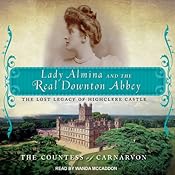My first princess that wasn't an animated Disney character was Princess Diana. I was six when Diana was killed in Paris, and while I don't remember much about it, I can remember how devastated people were when she passed away. It would seem fitting, in some morbid way, then that the fist princess I took interest in was Grace Kelly. Rear Window remains not only my favorite Grace Kelly film, but one of my favorite Hitchcock films of all time, right up there with North By Northwest. Grace Kelly's was a real life fairytale, the girl from Philadelphia staring some of the biggest movies of her day before meeting her real life prince. There are many interesting stories surrounding Grace Kelly, from her controversial death, to her relationship with her co-stars and Alfred Hitchcock, to the banning of her movies in Monaco, but she wasn't the only royal by any means to have an interesting life.
Lady Almina and the Real Downton Abbey is the story of Almina, the 5th Countess of Canarvon. The Carnavron family lives at Highclear Castle, the set of the British television series Downton Abbey written by Julian Fellows. Much like her fictional counterpart, Cora, Almina was an heiress, though Cora was American while Almina was British, whose money was used to rescue Highcleare from difficult financial times. The biographical account of Almina's life was compiled using Highcleare achieves and societal coverage from the late 1800s through WWI. The most interesting part of Almina's story for many comes with her financial support for an excavation led by her husband and Howard Carter in the Valley of the Kings in Egypt, an excavation that would lead to the discovery of King Tut's tomb. Almina's husband George was one of the fist victims of the Curse of King Tut, and the description of his passing is heart breaking.
Almina's passion for her husband and her country is touching, but what is missing from the account is a sense of person connection. The book does an admirable job of exploring Almina's contributions to Highcleare, but not much is said about her personal feelings about Highcleare. As a mother her past is almost overlooked, expect for a few sentences describing and ill-fated garden party with her son or the passion for fashion she passed on to her daughter.
Overall, the book is an interesting history of the 5th Countess of Canarvon and a tumultuous time in both British and world history. If reading about garden parties and turn of the century coming out parties is of interest I would recommend reading this book. It is very well put together and the pieces from the Highcleare achieve included in the book are fascinating.

No comments:
Post a Comment